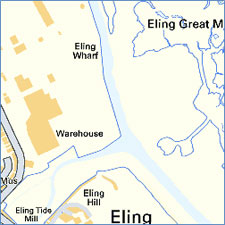WPA Consultants Ltd
Shears Building, Stone Lane Industrial Estate, Wimborne, Dorset, BH21 1HD
Tel: 01202 973020
CONTAMINATED LAND PROJECTS
Recently Completed Projects
Phase 1 and Phase 2 site investigations; Eling Wharf

Phase 1 and Phase 2 site investigations; Eling Wharf, adjacent to a container storage facility with an historic profile including tar works, naphthalene plant, chemical works and timber treatment facilities.
Action prompted by the reported presence of a naphthalene odour and bright yellow precipitate on the foreshore during exposure of a spring line during phases of outgoing tide. Work was undertaken on behalf of the local authority (regulator).
Objectives:
To
- Characterise the prior uses and environmental profile of the foreshore and the adjacent site and prepare an initial site conceptual model,
- Characterise the contaminants in soils and water of the foreshore above and below the high water mark,
- Establish the presence of tangible pathways for the migration of contaminants of concern from the container storage site, and/or to establish the likelihood of other contaminant sources,
- Prepare a detailed inspection report with a developed site conceptual model so that the regulator could adequately consider the exercise of its statutory duties.
Outcome:
- The documents and presentations prepared were used by the regulator to make representation to the Environment Agency so that the entire area of likely contamination might be considered and potentially determined as a special site.
- The Environment Agency together with the local authority have negotiated further voluntary investigation and remediation of the foreshore. Remediation of the container storage facility has also been assured as part of a DA requiring prerequisite EIA. The need for determination of the site has been avoided at this time.
Skills applied:
- Procuring information and undertaking research for initial desktop study.
- Project Management - preparing a sampling strategy and directing contractors involved with drilling/window sampling and trial pit excavation, direct involvement with sampling soils and groundwater, supervising sample handling and delivery of samples for analytical work.
- Risk Assessment involving the development of a site conceptual model of pollutant linkages, commencing with data assessment using statistical analysis and generic assessment criteria for soil and water, proceeding to the generation of site specific assessment criteria for further risk assessment (using CLEA 1.06 and RBCA). I used PBets analytical data to consider the bioaccessibility of heavy metals and modelled groundwater flow and tidal influence.
- Significant communication skills - writing reports, giving presentations and advising regulators, their lawyers and other stakeholders.
